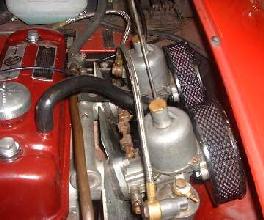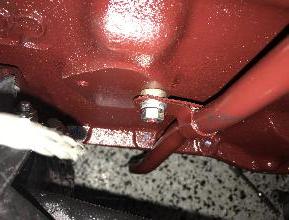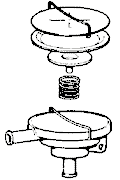The MGA With An Attitude
CRANKCASE VENTILATION BASICS - CV-100
First a word of caution. If crankcase ventilation is not done properly it can royally screw up the way the engine runs (and might possible damage the engine). Crankcase ventilation is often overlooked or done wrong (or not at all) when changing carburetors and intake manifolds. For crankcase ventilation to work it needs a low level vacuum source to pull air through the crankcase, and an air inlet vent into the crankcase (hopefully filtered intake air).
For all MGA and early MGB (18G engines 1962 to early 1964) the air inlet was a 1/2-inch hose from air filter to valve cover, while a very low level vacuum was provided by the 1/2-inch draft pipe on the front tappet cover (while the vehicle was in motion). Notice the special thick spacer washer behind the P-clip on the draft pipe. This spacer is often missing (which is why my draft pipe has a kink and a dent where it bears against the bottom flange of the engine block). MGA Twin Cam has the draft pipe on the rear tappet cover.


 Vent hose, air cleaner to valve cover Vent hose, air cleaner to valve cover Draft pipe dropping from tappet cover Draft pipe dropping from tappet cover


For the next system (18GA/GB/GF engines late 1964-1968) the front tappet cover was connected to a PCV valve which was connected to the intake manifold. The PCV valve regulated a constant low level vacuum in the crankcase and would accept any (variable) amount of blow-by gases. To prevent excessive fresh air flow through the crankcase into the intake manifold, the air intake was restricted by a small orifice in the oil filler cap (and also had an air filter in the filler cap).
For the 18GH engine in 1969, the PCV valve was deleted, and the low level vacuum was provided by a venturi vacuum source on the carburetors. Air intake to the crankcase was still through the restricted and filtered oil filler cap.
Beginning 1970 there was fuel vapor recovery with a carbon canister. The oil filler cap was then sealed, and vent air was drawn into the crankcase through a restricted fitting on the back of the valve cover which was connected to the carbon canister (which also served as the intake air filter).
Through all of this, the idea is that there needs to be some fresh air circulating through the crankcase to remove water vapor (which is a byproduct of combustion). Without fresh air intake into the crankcase the water will accumulate to form emulsified water/oil scum in the crankcase (looks like dirty Mayonnaise in the valve cover), and the water can contaminate and dilute engine oil.
|